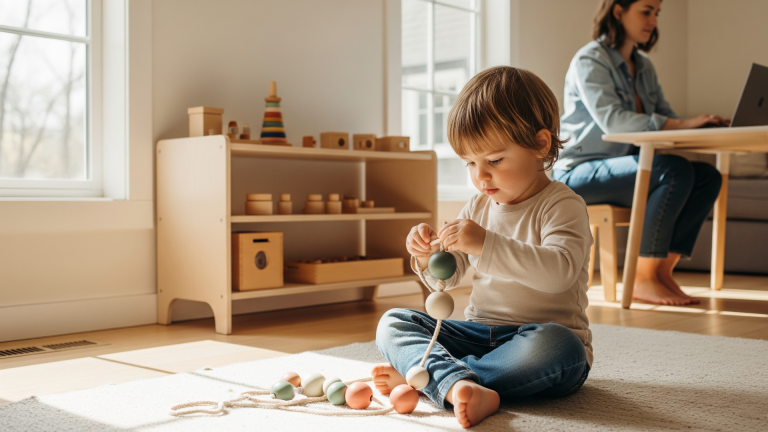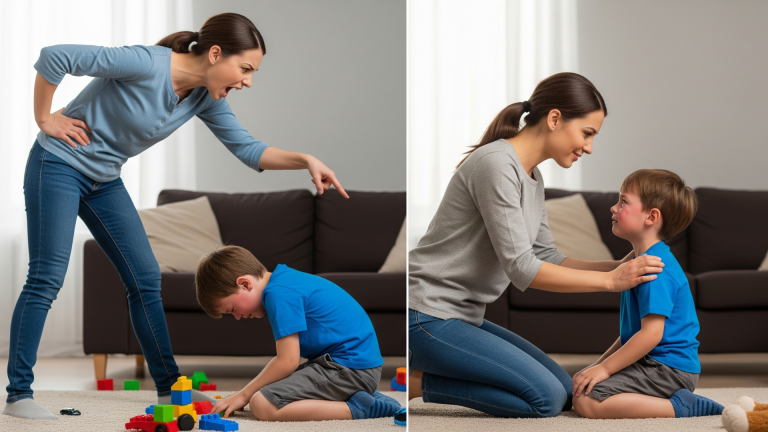Mom Guilt Is a Lie: Here’s How to Let It Go
Every mom feels guilt at some point. Working moms often feel it twice. There is the pressure to be fully present at home and fully excellent at work. Then there is the pressure to do it all with a smile. That cocktail produces a steady hum of “I should be doing more.”
Here is the truth: most mom guilt is not a moral alarm. It is a signal built from unrealistic standards, social comparison, and noise. The point of this article is simple. We will define mom guilt meaning, explain why so much of it is fiction, and then show how to overcome mom guilt with practical steps you can use today.
Take one breath. Drop your shoulders. You are not on trial.
What Mom Guilt Really Means
Plain definition. Mom guilt is the persistent feeling that you are falling short as a mother, even when your child is safe, loved, and basically fine. It shows up as intrusive thoughts, self-criticism, and an urge to “make up for” something that may not even be a real problem.
Everyday examples. You let the kids watch a show so you can make dinner. You miss a school event because your shift ran long. You serve frozen pizza after a long day. You pause playtime because you need ten quiet minutes. None of these mean you are a careless parent. They mean you are a human with limited time and energy.
Where it really comes from. Guilt is often generated by invisible rules. Some you learned growing up. Some you absorbed through social media highlight reels. Some you pieced together from conflicting parenting advice. These rules are rarely written down, yet they run the show. When you compare your real life to that fantasy standard, you feel a gap. That gap is guilt.
Key insight. Guilt should reflect a real misalignment with your values. It should help you course-correct when you have truly crossed a line. Most mom guilt is better labeled as pressure or fear. Pressure to match a perfect image. Fear of being judged. Those are not the same as a genuine parenting mistake.
Related read: The 4 Parenting Styles Explained for Modern Moms
Why Mom Guilt Is a Lie
The perfect mom myth. The “always present, always patient, always organic, always calm” mother is a modern legend. She never loses her temper, never forgets spirit day, and never opens a can of soup. That image is not a standard. It is a sales pitch. It keeps you buying more solutions for a problem that does not exist.
The comparison trap. Social media amplifies this by serving edited moments as if they were average days. You see the one smiling photo after a chaotic morning and think you are the only one scrambling. You are not. Everyone is doing tradeoffs you cannot see.
Why working moms often feel it more. Working mothers manage two domains that both carry heavy expectations. At work, high standards are often explicit. At home, they are unspoken yet powerful. When those expectations collide, guilt blooms. That does not mean your kids are harmed by your job. Large cross-national research links maternal employment to positive long-term outcomes for children, including daughters’ higher employment and leadership rates and sons’ greater participation in family care. In other words, your example is not only “good enough.” It can be an asset. (SAGE Journals)
Reality check. Kids do not need a flawless mother. They need a stable, loving one. Stability comes from routines, boundaries, repair after conflict, and consistent care. None of that requires perfection or constant availability.
The cost of guilt. Chronic guilt steals presence. It pushes you to multitask when you should rest and to strive when you should connect. It turns neutral events into moral verdicts. Over time, that pressure raises stress and burnout, which makes patience harder and connection weaker. The lie of mom guilt is that it keeps you “on track.” In reality, it pulls you off it.
See also: Authoritative Parenting: Why It’s the Gold Standard
Spotting Mom Guilt in the Moment
Common signs. Watch for looping thoughts. “I should have…” or “A better mom would…” Note the bodily telltales. Tight jaw. Knot in the stomach. A rush to fix things so you can feel clean again. Also watch for compare-and-despair. If your mood changes after a quick scroll, that is a signal.
A simple self-check. When guilt hits, ask one question: “Is this about my child’s actual needs, or my fear of being judged?” If it is about your child’s needs, act. If it is about fear, challenge the story.
Put your hand on your chest and name the moment. “This is guilt. I am safe. My child is safe. I can choose what matters now.” It looks small. It is not. Naming reduces the emotion’s grip.
How to Overcome Mom Guilt (Practical Strategies)
You do not need a personality transplant. You need a set of repeatable moves. Treat these like tools in a drawer. Use what fits the moment.
1) Reframe mistakes as learning, not failure
You lost your temper. You forgot the permission slip. You double-booked and missed bedtime. These are mistakes, not identity statements. Repair beats perfection. Model what repair looks like.
Repair teaches kids that relationships can be strong and flexible. It also trains your brain to see mistakes as bridges back to connection, not cliffs.
2) Adopt a “good enough and loving” mindset
“Good enough” is not sloppy. It is calibrated. It means you aim for consistency over spectacle. Your kids benefit most from dependable rhythms, not grand gestures. Choose clear anchors: shared meals when possible, bedtime rituals, regular check-ins, movement outside, and a predictable screen plan.
Evidence note on screens. Many parents carry heavy guilt about screen time. The American Academy of Pediatrics updated guidance recognizes there is no single limit that fits all older children. Quality, context, and family values matter more than a rigid number. For young children, limits and co-viewing remain key. For older kids, the focus is on mindful use, sleep protection, and content quality.
Helpful explainer: What Screen Time Really Means for Kids Today
Practical move. Write a simple family media plan. Two or three rules are enough. For example: no devices at meals, devices charge outside bedrooms, and screens off one hour before bed. Simplicity drives follow-through.
3) Build realistic routines and boundaries
Routines reduce decision fatigue. Boundaries reduce resentment. Put those together and guilt loses oxygen.
4) Use self-talk swaps that reduce guilt and increase compassion
Self-compassion is not indulgence. It is a performance tool. It reduces stress and improves problem-solving. A systematic review of parenting interventions that included self-compassion components found measurable reductions in parental depression, anxiety, and stress, along with increases in self-compassion itself. That is not fluff. That is practical psychology you can use. (Self-Compassion)
Try these swaps.
Micro-practice. Place a sticky note where you will see it: “Talk to yourself like you would to your child.”
5) Make screen time balanced, not a battleground
Kids love screens because screens are designed to be engaging. That is not a moral failing. Use structure to keep things balanced.
Remember, the goal is not zero screens. It is right-sized screens in a life that includes play, movement, chores, rest, and face-to-face time. The AAP’s stance is to prioritize quality content and healthy routines rather than a universal clock number for every family.
6) Model healthy ambition and limits, especially if you are a working mom
Your work teaches your children about effort, responsibility, and identity beyond one role. Research on maternal employment shows long-run benefits for children, including daughters’ higher employment and leadership likelihood and sons’ increased family involvement. Let this reframe your narrative. Your work can be a gift to your family, not a detour from it.
Tactical moves.
7) Use “one step now” as your default reset
Guilt makes you want to overhaul everything. Overhauls collapse. Choose one step.
One step reduces noise. Reduced noise makes space for connection. Connection crowds out guilt.
Stand up. Shake your hands out. Take three slow breaths. This is a reset you can do anywhere. It works.
FAQs on Mom Guilt
What does mom guilt mean?
Mom guilt is the feeling that you are not measuring up as a mother, often without evidence of harm. It is driven by internal rules and external pressure. The test is whether your feeling points to a real value conflict or to fear of judgment. If it is fear, challenge it. If it is a true value conflict, take a small corrective step.
Is working mom guilt normal?
Yes. It is common because working moms juggle expectations in two demanding arenas. Normal does not mean helpful. Reframe your work as part of your family’s stability and your child’s modeling. The long-term data on maternal employment and adult children’s outcomes is reassuring.
How do I stop feeling guilty as a mom?
You do not eliminate guilt. You reduce its power. Use the self-check question. Build simple routines that match your values. Practice self-compassion so your brain learns to recover faster after mistakes. There is solid evidence that self-compassion practices reduce parental stress and distress.
What is the difference between guilt and real parenting mistakes?
Guilt is a feeling. Mistakes are events. When you cross one of your values, repair it and adjust a routine. When you feel guilty without a clear value at stake, it is usually social comparison. Do not give that the keys.
How can I let go of guilt without feeling careless?
Replace the myth of perfection with a values map. Decide what matters most this season. Sleep, family meals, homework support, and calm bedtimes are good anchors. If a decision supports those priorities, it is not careless. It is aligned. If you need a rule, use this: connection over performance, repair over perfection, routines over drama.
Whisper this to yourself. “Present, not perfect.” Simple phrases stick better than complex plans.
Extra resource: Positive Parenting Tips for Stronger Bonds
When to Seek Extra Support
Guilt that does not let up can shade into anxiety, depressed mood, or parental burnout. Signs include chronic irritability, numbness, sleep disruption unrelated to infant care, and a constant urge to escape. If you notice these patterns for two weeks or more, loop in support. Start with your primary care clinician or therapist. Share specific snapshots of your day. Ask for screening and tools.
If you’re running low on energy, check out our guide for recovering from burnout: 7 real-world energy steps.
Peer support helps too. Join a low-pressure circle. One local group. One online forum with sensible ground rules. You are looking for practical, not perfect. You want people who share ideas without scorekeeping.
If your family rhythms are frayed, ask a partner, relative, or friend for concrete help. A school pickup trade. A dinner swap once a week. An hour window where you can walk alone. Practical help turns theory into relief.
Evidence-informed guardrails. If screens are part of the stress, tighten the basics: keep devices out of bedrooms, avoid screens before bed, and choose quality content. These small moves reduce sleep disruption and arguments, which lowers the ambient stress that fuels guilt. The AAP guidance supports this quality-first, routine-centered approach. (aap.org)
Related: What Is Positive Discipline? Explained for Parents
Conclusion / Takeaway
Mom guilt is a persistent storyteller. It whispers that every tradeoff is a failure and every imperfect moment is a verdict. That story is false. You can write a different one.
See guilt for what it is. A signal to check your values, not a sentence you must carry. Build simple routines so your days hum instead of scrape. Use self-compassion so your brain learns to recover fast. Remember that working mom guilt does not reflect your child’s fate. The best evidence we have says your example can widen your kids’ view of what a healthy adult life can look like.
Letting go of guilt is not a luxury. It is how you show up with steadiness and warmth. Your kids do not need a perfect mother. They need you present, rested where possible, honest when you miss, and willing to repair. If you choose connection over performance today, you win the only game that matters.
Close your eyes for three slow breaths. Picture tonight. One small ritual. Ten minutes that belong to you and your child. That is the work. That is enough.








